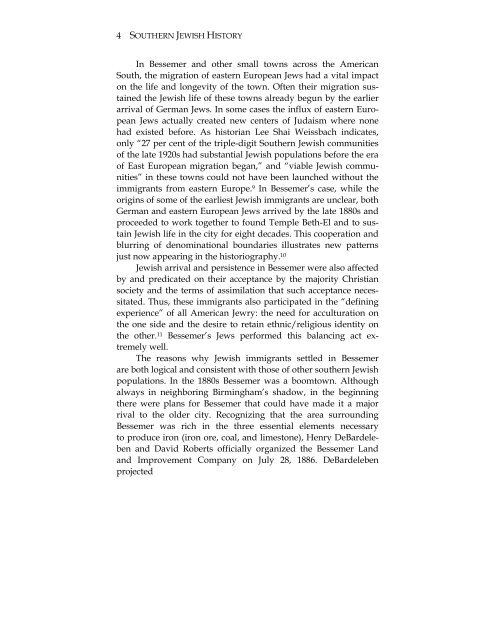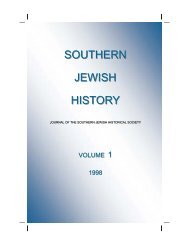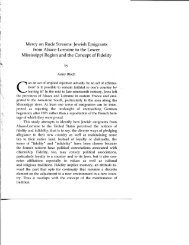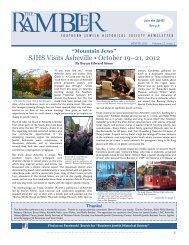A Shtetl Grew in Bessemer - Southern Jewish Historical Society
A Shtetl Grew in Bessemer - Southern Jewish Historical Society
A Shtetl Grew in Bessemer - Southern Jewish Historical Society
Create successful ePaper yourself
Turn your PDF publications into a flip-book with our unique Google optimized e-Paper software.
4 SOUTHERN JEWISH HISTORY<br />
In <strong>Bessemer</strong> and other small towns across the American<br />
South, the migration of eastern European Jews had a vital impact<br />
on the life and longevity of the town. Often their migration susta<strong>in</strong>ed<br />
the <strong>Jewish</strong> life of these towns already begun by the earlier<br />
arrival of German Jews. In some cases the <strong>in</strong>flux of eastern European<br />
Jews actually created new centers of Judaism where none<br />
had existed before. As historian Lee Shai Weissbach <strong>in</strong>dicates,<br />
only “27 per cent of the triple-digit <strong>Southern</strong> <strong>Jewish</strong> communities<br />
of the late 1920s had substantial <strong>Jewish</strong> populations before the era<br />
of East European migration began,” and “viable <strong>Jewish</strong> communities”<br />
<strong>in</strong> these towns could not have been launched without the<br />
immigrants from eastern Europe. 9 In <strong>Bessemer</strong>’s case, while the<br />
orig<strong>in</strong>s of some of the earliest <strong>Jewish</strong> immigrants are unclear, both<br />
German and eastern European Jews arrived by the late 1880s and<br />
proceeded to work together to found Temple Beth-El and to susta<strong>in</strong><br />
<strong>Jewish</strong> life <strong>in</strong> the city for eight decades. This cooperation and<br />
blurr<strong>in</strong>g of denom<strong>in</strong>ational boundaries illustrates new patterns<br />
just now appear<strong>in</strong>g <strong>in</strong> the historiography. 10<br />
<strong>Jewish</strong> arrival and persistence <strong>in</strong> <strong>Bessemer</strong> were also affected<br />
by and predicated on their acceptance by the majority Christian<br />
society and the terms of assimilation that such acceptance necessitated.<br />
Thus, these immigrants also participated <strong>in</strong> the “def<strong>in</strong><strong>in</strong>g<br />
experience” of all American Jewry: the need for acculturation on<br />
the one side and the desire to reta<strong>in</strong> ethnic/religious identity on<br />
the other. 11 <strong>Bessemer</strong>’s Jews performed this balanc<strong>in</strong>g act extremely<br />
well.<br />
The reasons why <strong>Jewish</strong> immigrants settled <strong>in</strong> <strong>Bessemer</strong><br />
are both logical and consistent with those of other southern <strong>Jewish</strong><br />
populations. In the 1880s <strong>Bessemer</strong> was a boomtown. Although<br />
always <strong>in</strong> neighbor<strong>in</strong>g Birm<strong>in</strong>gham’s shadow, <strong>in</strong> the beg<strong>in</strong>n<strong>in</strong>g<br />
there were plans for <strong>Bessemer</strong> that could have made it a major<br />
rival to the older city. Recogniz<strong>in</strong>g that the area surround<strong>in</strong>g<br />
<strong>Bessemer</strong> was rich <strong>in</strong> the three essential elements necessary<br />
to produce iron (iron ore, coal, and limestone), Henry DeBardeleben<br />
and David Roberts officially organized the <strong>Bessemer</strong> Land<br />
and Improvement Company on July 28, 1886. DeBardeleben<br />
projected







